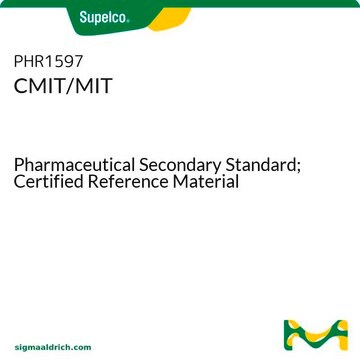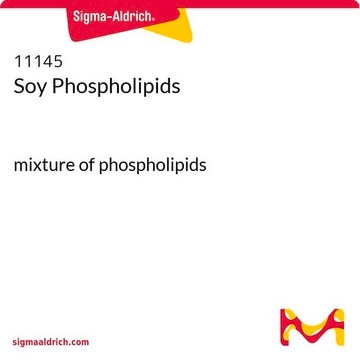725765
2-Methyl-4-isothiazolin-3-one
95%
Synonym(s):
2-Methyl-3(2H)-isothiazolone
About This Item
Recommended Products
Assay
≥94.0% (GC)
95%
form
lumps
impurities
≤5% water
SMILES string
CN1SC=CC1=O
InChI
1S/C4H5NOS/c1-5-4(6)2-3-7-5/h2-3H,1H3
InChI key
BEGLCMHJXHIJLR-UHFFFAOYSA-N
Looking for similar products? Visit Product Comparison Guide
Application
- Insights into the mechanisms of within-species variation in sensitivity to chemicals: A case study using daphnids exposed to CMIT/MIT biocide.: This study investigates the differential sensitivity of daphnids to 2-Methyl-4-isothiazolin-3-one, highlighting the biochemical mechanisms underlying these variations. The findings provide crucial insights for environmental safety assessments (Kim et al., 2023).
- Effects of the biocide methylisothiazolinone on Xenopus laevis wound healing and tail regeneration.: The study assesses the impact of 2-Methyl-4-isothiazolin-3-one on regenerative processes in amphibians, contributing to the understanding of its biological effects and potential toxicity (Delos Santos et al., 2016).
- T cell lymphomatoid contact dermatitis: a challenging case and review of the literature.: This review includes discussions on 2-Methyl-4-isothiazolin-3-one-induced contact dermatitis, providing valuable information for dermatological applications and safety assessments (Knackstedt and Zug, 2015).
Signal Word
Danger
Hazard Statements
Precautionary Statements
Hazard Classifications
Acute Tox. 2 Inhalation - Acute Tox. 3 Dermal - Acute Tox. 3 Oral - Aquatic Acute 1 - Aquatic Chronic 1 - Eye Dam. 1 - Skin Corr. 1B - Skin Sens. 1A
Supplementary Hazards
Storage Class Code
6.1A - Combustible acute toxic Cat. 1 and 2 / very toxic hazardous materials
WGK
WGK 3
Flash Point(F)
Not applicable
Flash Point(C)
Not applicable
Personal Protective Equipment
Certificates of Analysis (COA)
Search for Certificates of Analysis (COA) by entering the products Lot/Batch Number. Lot and Batch Numbers can be found on a product’s label following the words ‘Lot’ or ‘Batch’.
Already Own This Product?
Find documentation for the products that you have recently purchased in the Document Library.
Customers Also Viewed
Our team of scientists has experience in all areas of research including Life Science, Material Science, Chemical Synthesis, Chromatography, Analytical and many others.
Contact Technical Service











